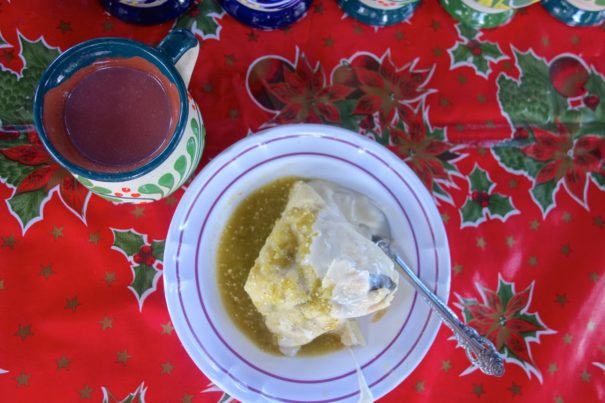
You Know the Breakfast Is Good When You Don’t Even Care About the Peyote Part

You Know the Breakfast Is Good When You Don’t Even Care About the Peyote Part
Corundas in Patzcuaro
The entrance to Patzcuaro’s basilica is lined with nutritional supplements, the ailments they cure scribbled on bright, neon paper and taped to the stone courtyard walls. The basilica is dedicated to Patzcuaro’s patron saint, Our Lady of Health, and people make pilgrimages here to pray for medical miracles. A long time ago, I bought a lighter with her on it, which I thought was ironic when I used it to light a joint at home. As we pass by, the signs make me anxious and I try to think of possible future health problems I should pray for in advance.
But hunger comes to mind first. It’s 11 a.m. and my mom is taking me to her favorite corunda stand for breakfast, right in front of the basilica. Corundas are Michoacan’s staple tamales: unlike most tamales you see in the U.S., these are pyramid-shaped and wrapped in corn leaves, not the husks. I haven’t had one since my parents lived here over a decade ago. This is my first visit with them on their annual summer trip back.
The owner’s daughter, Clara, is manning the stand today, a picnic table covered in a Christmas-themed oilcloth. We order a large corunda and she picks it out of a tall pot, unwrapping it and covering it in a bright, tangy tomatillo salsa and cream. It’s creamy, a little spicy, salty, filled with a spongy cheese and mild green peppers, and the dough melts in my mouth. We also order the guava atole, a thick, corn-based drink stained pink from fresh guava. She has cinnamon, tamarind, and chocolate flavors, too.
Patzcuaro is 7,000 feet above sea-level and the basilica is perched on a hill overlooking a lake that looks silver in the cold mornings and brown when you get up close. The rain clouds hover behind us, and the breeze smells like exhaust and mountains. Across the way, vendors hawk moringa supplements for cholesterol, diabetes, and bad circulation. Mamey juice for cysts, cancerous tumors, ulcers, internal bruises, and prostate inflammation. There’s arnica with peyote and arnica with marijuana, and bags with their sides rolled down that look like nests filled with herbs and sticks.
Michoacán is a state known for its agricultural bounty and indigenous cooking traditions. Tortillas are made with heirloom corn, avocado orchards hug the highways, and cooking with market ingredients is the norm. I watch Clara buy bright green corn leaves from a man carrying them around on his back. Breakfast reminds me of a cookbook I have at home called Decolonize Your Diet. It offers recipes using mostly heritage crops in Mexico, encouraging ancestral cooking as a source of protection from modern disease. It’s about good food, not as a replacement to modern medicine, but as essential to healing.
After we eat, I pressure my mom to try some of the arnica with marijuana salve on her wrist, mostly for fun. It’s an unnatural, chemical yellow, giving off whiffs of some kind of plastic version of eucalyptus. Up close, a few of the other products look equally artificial. The signs say they heal everything, but I just want another corunda.